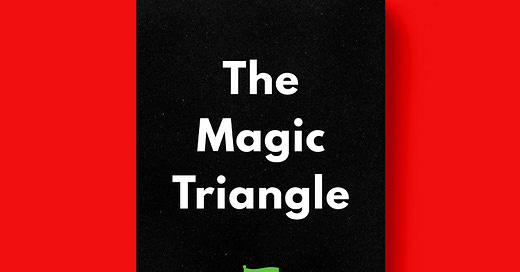The Magic Triangle: Why Category Design Is The Single Point Of Failure
No category, no meaningful company.
Arrrrr! 🏴☠️ Welcome to a 🔒 subscriber-only edition 🔒 of Category Pirates. Each week, we share radically different ideas to help you design new and different categories. For more: View the mini-book archive | Listen to a category design jam session | Dive into an audiobook | Enroll in the free Category Accelerator email course
Dear Friend, Subscriber, and fellow Category Pirate,
Have you ever noticed how often business and marketing content is stuffed with prescriptions?
Stuff like, “The 7 Things Elon Musk Does Before Breakfast” and “Why Steve Jobs Wore Boxer Shorts, And You Should Too.” We’ve become a culture of quick tips, growth hacks, and short-term solutions where the primary value being given to the reader is the answer.
Not a reframing of the question.
In reality, the entrepreneurs, innovators, and artists moving the world forward are unconcerned with other people’s Tip Of The Day. They are thinkers who believe that thinking about thinking is the most important kind of thinking. They want to be given questions to consider (because questions spark thinking), not surface-level conclusions to nuanced and complicated problems.
And since we believe you are that sort of person (you are reading Category Pirates, after all), we do not want to sit here and try to give you quick-tip-answers.
Instead, we want to give you frameworks, mental models, and new ways of seeing the world. Becoming a Category Designer means thinking in orthogonal ways, which is why our goal with these letters is to help you consider new and different contexts to old and commonly accepted problems.
Previous letters covering various frameworks include:
But today, we’d like to introduce you to a new lens for interpreting the business world.
A lens that can dramatically improve your odds of becoming a Category King or Queen yourself.
Because once you see the world through what we like to call “The Magic Triangle,” you’ll never see things the same way again.
“The Magic Triangle”
The Magic Triangle is the combination of product design, company design, and category design—each side with equal importance, ideally executed at the same time.
Product Design: The purposeful building of a product and experience that solves the problem the category needs solved. The goal here is what the business world traditionally calls “product-market fit”—which we see as strategically flawed thinking. What you really want is “product/category fit” (which we’ll clarify later in this letter).
Company Design: The purposeful creation of a business model and an organization with a culture and point of view that fits with the new category. The goal here is company/category fit, meaning you have engineered the right business model and missionary team for the problem you are looking to solve.
Category Design: The mindful creation and development of a new market category, designed so the category will pull in customers who will then make the company its Queen. In marketing terms, this is about winning over popular opinion, and teaching the world to abandon the old and embrace the new.
All three elements—company design, product design, and category design—work together and balance each other to exert great force on a company’s success and value. And the legendary, enduring companies get the three elements of company design, product design, and category design in such a state of synchronicity that they reinforce each other.
Finally, the elite Category Kings & Queens recognize that each area of The Magic Triangle generates data about the future of the category. Most companies with data scientists focus on gathering data about the product to improve the product. Or, they gather data about the company to improve the company. Or, they do “deep data dives” on customer behavior for the myopic purpose of improving “customer experience.” But very few companies gather and leverage data naturally generated by their products and company to forecast the future of the category.
This is what we call the Data Flywheel, which creates momentum for all three sides of The Magic Triangle:
The product
The company & underlying business model
And the company’s leadership position in their chosen category
When entrepreneurs successfully prosecute this Magic Triangle, they change the world.
The big question is, “How?”






